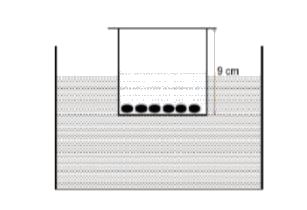Two identical metallic square loops L1 and L2 are placed next to each other with their sides parallel on a smooth horizontal table. Loop L1 is fixed and a current which increases as a function of time is passed through it. Then loop L2
rotates about its center of mass
moves towards L1.
remains stationary
moves away from L1
The correct Answer is:D
Step by step video, text & image solution for Two identical metallic square loops L_(1) " and " L_(2) are placed next to each other with their sides parallel on a smooth horizontal table. Loop L_(1) is fixed and a current which increases as a function of time is passed through it. Then loop L_(2) by Physics experts to help you in doubts & scoring excellent marks in Class 12 exams.
Updated on:21/07/2023Topper's Solved these Questions
Similar Questions
A wide bottom cylindrical massless plastic container of height 9 cm has 40 identical coins inside it and is floating on water with 3 cm inside the water. If we start putting more of such coins on its lid. It is observed that after N coins are put, its equilibrium changes from stable to unstable. Equilibrium in floating is stable if the geometric center of the submerged portion is above the center of mass of the object) The value of N is closed to

View SolutionThere are two stationary loops with mutual inductance L_(12) . The current is one of the loops starts to be varied as I_(1) = alpha t where alpha is a current, t is time. Find the time dependence I_(2) (t) of the current in the other loop whose inductance is L_(2) and resistance R .
View Solutionदो प्रेरकत्व L1 तथा L2 समान्तरक्रम में जोड़े गए है और उनसे एक प्रत्यावर्ती धारा प्रवाहित होती है | यदि धाराएँ I1 और I2 क्रमश: L1 तथा L2 से किसी नियत समय पर प्रवाहित हो रही हो, तो धारा I1/I2 का अनुपात होगा
View SolutionLet L be the set of all straight lines in plane. l1 and l2 are two lines in the set. R1,R2 and R3 are defined relations.
(i) l1R1l2:l1 is parallel to l2
(ii) l1R2l2:l1 is perpendicular to l2
(iii) l1R3l2:l1 intersects l2
Then which of the following is true ?
View SolutionIf l1,l2 and l3 are the orders of the currents through our nerves, domestic appliances and average lightening, then the correct order of currents is
(1) l1>l2>l3 (2) l1>l3>l2
(3) l1<l2<l3 (4) l1=l2=l3
View Solutionदो प्रेरक कुण्डलियों के स्वप्रेरकत्व व L1 व L2 है। सिद्ध कीजिए की इन्हे
समान्तर क्रम में जोड़ने पर तुल्य प्रेरकत्व L1L2/(L1+L2) होगा ।
View Solutionयदि L1,L2,L3.... स्वप्रेरकत्व की कुण्डलियाँ समान्तर क्रम में जुडी है तथा परिणामी स्वप्रेरकत्व L है तो
1L=1L1+1L2+1L3+.....
View SolutionFind the values of ointvecB.vecdl for the loops L_(1),L_(2),L_(3) in the figure shown . The sence of vecdl is mentioned in the figure.
View SolutionTwo circular loops L1 and L2 of wire carrying equal and opposite currents are placed parallel to each other with a common axis. The radius of loop L1 is R1 and that of L2 is R2. The distance between the centres of the loops is √3R1. The magnetic field at the centre of L2 shall be zero, if
View SolutionIn the example (2), the current flowing through the wire is ll=l0sinωt. What is the flux through the loop at t=π2ω?
View Solutionधात्विक तार के दो समरूप वृत्ताकार लूप एक मेज पर बिना परस्पर स्पर्श किए हुए रखे गए हैं। लूप A में धारा समय के साथ बढ़ती है। उसकी अनुक्रिया में लूप B
View SolutionTwo coherent circular loops of diameters 3 cm and 4 cm L_(1) And L_(2) Are placed as shown in the figure. The loop L_(2) What is the magnitude and direction of the current in that the net magnetic field at point O is zero?
View SolutionA circular driver loop is connected to the battery as pictured. Part ABC Length l_(1) , And length of ADC l_(2)
View Solutionदो किरणें बिन्दु A से निकलती है तथा एक दूसरे के साथ 43∘ का कोण बनाती है। रेखायें L1,L2 तथा L3 (जिनमें से कोई भी दो समान्तर नहीं, प्रत्येक मूल किरणों के साथ समद्विबाहु त्रिभुज का निर्माण करती है। रेखाओं L1,L2 , तथा L3 ,द्वारा निर्मित त्रिभुज का सबसे बड़ा कोण होगा
View SolutionLet L be the set of all straight lines in plane. l1 and l2 are two lines in the set. R1,R2 and R3 are defined relations.
(i) l1R1l2:l1 is parallel to l2
(ii) l1R2l2:l1 is perpendicular to l2
(iii) l1R3l2:l1 intersects l2
Then which of the following is true ?
View Solution
